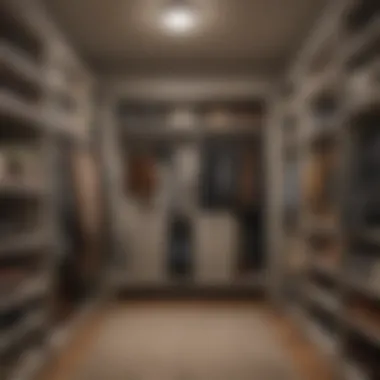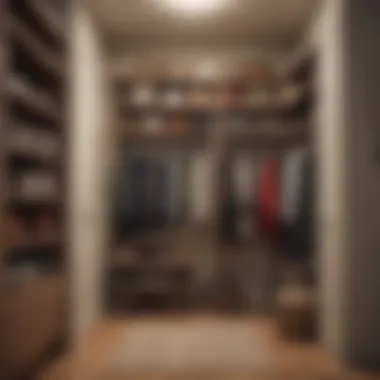Ultimate Guide to Mastering Your Coat Closet Organization


Intro
Organizing a coat closet may seem like a simple task, but it encompasses a variety of strategies to transform a chaotic jumble into an efficient, functional space. Understanding the intricacies of this process can greatly enhance the utility of your home. This guide delves into the fundamental aspects of organizational techniques, offering insights into design, functionality, and maintenance.
A well-organized coat closet not only maximizes space but also contributes to the overall aesthetic of your home. With an array of design inspirations and practical tips, readers will find ways to optimize their coat closets for both everyday use and seasonal transitions.
Design Inspiration
Trending Styles
The current trends focus on minimalism and functionality. Coat closets that integrate open shelving, clear bins, and smart hooks showcase an uncluttered look. Additionally, sliding doors or curtains can add a modern touch while keeping out dust and enhancing accessibility.
When thinking about style, consider a design that complements your overall home décor. For instance, a rustic wooden shelf can offer charm to a modern space, while sleek metal hooks might work better in a contemporary home.
Color Palettes
Color plays a crucial role in the visual appeal of your coat closet. Neutral tones like whites and greys can create a calm atmosphere, while vibrant colors can make the space more inviting. For homeowners looking to add an element of fun, consider accent colors for storage bins or hooks. This approach allows personal expression while keeping the closet functional.
Practical Tips
Maintenance & Care
Maintaining an organized coat closet requires a commitment to regular upkeep. Designate specific times to declutter and reassess the organization of the space. A good practice is to perform a full review at the change of seasons or when adding new items to the closet. Regularly check for items you no longer need or use, and donate them to create space.
Budgeting & Planning
Budgeting is essential when organizing a closet. Identify a reasonable budget that reflects your desired changes. Investing in quality organizational tools can be beneficial in the long run. Consider options like shelving systems from IKEA or bins from The Container Store to find a combination that fits both your vision and your expenditure limits.
By approaching the organization of your coat closet methodically, you can create a system that serves your needs while reflecting your personal style. Implementing thoughtful design ideas and maintaining regular care will ensure your coat closet remains a valuable asset in your home.
Understanding the Importance of an Organized Coat Closet
Organizing a coat closet is a key area of home management. While it may seem minor, the impact of a well-kept coat closet is significant. This space is more than a simple storage location; it serves as a gateway to your home, where first impressions often are formed. An organized coat closet can boost functionality and aesthetics.
The Role of a Coat Closet in Home Organization
A coat closet functions as a central storage area for outerwear and accessories. It holds coats, jackets, hats, and gloves. When well-organized, it allows for easy access to items without clutter. The design of this closet can influence the flow and usability of the surrounding space. For instance, entering a home with a tidy entryway establishes a welcoming atmosphere.
Moreover, a well-maintained coat closet promotes efficiency. It simplifies the decision-making process when selecting outerwear based on the day’s weather or occasion. Homes often lack sufficient storage, so maximizing every inch of space is essential. An organized coat closet not only enhances the organization of coats but also provides a designated area for other accessories or seasonal items.
Advantages of a Well-Organized Space
Several advantages arise from maintaining an organized coat closet. These include:
- Easier Access: An organized closet means you can quickly find what you need without sifting through piles. This saves time, especially during hectic mornings.
- Increased Space: Removing unnecessary items helps maximize the available space. An organized closet can accommodate more items, reducing the need for additional storage solutions elsewhere in the home.
- Improved Aesthetics: A stylishly arranged closet can enhance the overall appearance of your entryway. Neat storage options can contribute to a well-designed look.
- Enhanced Longevity of Items: Proper organization encourages better care of your belongings, which can lead to a longer lifespan for your coats and accessories. When items are stored appropriately, they are less likely to become damaged or worn.
- Dynamic Flexibility: A dynamic organization system can adapt to changes in seasons or needs. An organized closet makes it easier to transition between seasons, by simply rotating out items as needed.
In summary, organizing a coat closet is far more than a simple task; it plays a crucial role in home efficiency, aesthetics and functionality. By recognizing its importance, homeowners can take steps to ensure their coat closet is systematic, adaptable, and visually appealing. The effort you put into organization reflects positively on the entire home.
Assessing Your Current Closet Condition
To effectively organize a coat closet, it is essential to start with a clear understanding of its current condition. This phase is not merely about evaluating the visible clutter but about comprehensively examining the space's utility and functionality. An organized coat closet can significantly enhance the overall flow of your home while also providing efficient storage for seasonal items and accessories. By taking the time to assess your closet, you set the groundwork for a more streamlined organization process.
Evaluating Storage Capacity
One of the first steps in assessing your coat closet is to evaluate its storage capacity. This involves understanding the physical dimensions of the closet as well as its storage components. Measure the height, width, and depth to determine the available space. Consider how much space is currently occupied and how much is left unutilized.
Examine the various organizational tools you already have in place, such as shelves or racks. Ask yourself the following:


- How many coats, jackets, and accessories do I currently store?
- Is there enough vertical space for hanging items, or could additional hooks or rods be added?
- Are shelves present and suited for items such as hats or gloves?
- What types of bins or baskets could be incorporated to maximize storage?
Investing time into accurately understanding the scope of your storage capacity can reveal hidden potential in your coat closet. This ensures that every item has a designated place, making retrieval swift and hassle-free.
Identifying Existing Problems
After assessing storage capacity, the next step is identifying existing problems in your coat closet. Often, issues may not be immediately visible but can significantly affect functionality. This involves addressing clutter, inefficient layout, or inadequate storage solutions.
Common problems include:
- Overflowing items that make it hard to find what you need.
- Lack of organization which leads to wasted time searching for a specific item.
- Items that serve no current purpose and take up valuable space.
- Potential damage to clothing from overcrowding or lack of proper storage.
Consider making a list of these issues for better clarity. Recognizing problems enables targeted solutions.
"An organized coat closet not only enhances functionality but also reflects personal style and choice."
In summary, by thoroughly assessing your current closet condition, you can identify opportunities for improvement. This crucial step paves the way for a more effective organizational strategy tailored to your specific needs.
Decluttering Your Coat Closet
Decluttering your coat closet is a pivotal step in achieving a well-organized space. It serves not only to maximize the available storage but also enhances the overall functionality and aesthetics of your home. When a closet is cluttered, it becomes difficult to find items efficiently, leading to frustration. By removing unnecessary items and organizing what remains, you can create a more streamlined system that saves time and improves usability.
Establishing Item Categories
To effectively declutter, the first step is to establish item categories. Grouping similar items makes it easier to assess what you have and decide on the next steps. Common categories for a coat closet may include:
- Outerwear: These are your coats, jackets, and heavy sweaters.
- Seasonal Items: This includes heavier winter gear or lighter raincoats.
- Accessories: Scarves, gloves, and hats all fit in this category.
- Footwear: Consider organizing items like boots, shoes, or slippers.
By sorting items this way, you can quickly identify duplicates, items that no longer fit, or those that are rarely used. This method provides clarity and can motivate you to make decisive choices about your belongings.
Deciding What to Keep, Donate, or Discard
Making choices about what to keep, donate, or discard is often the hardest part of decluttering. Having a clear criterion can aid in this decision-making process. Consider these factors:
- Condition: If an item is damaged beyond repair or heavily worn, it may be time to discard it.
- Frequency of Use: Ask yourself if you have worn an item in the past year. If not, it might be best to let it go.
- Sentimental Value: Items that hold strong sentimental value can be kept, but be cautious not to let emotions cloud your judgment regarding space.
- Usability: Evaluate whether the items still fit your lifestyle. An old coat from a time when you lived in a different climate may no longer serve you.
"Out of sight, out of mind often leads to overstuffed closets that need attention."
By objectively evaluating your belongings, you can simplify your coat closet. Ultimately, a well-curated collection will make it easier to maintain organization.
Decluttering is more than just a physical act; it is a mental shift that encourages a more mindful approach to home organization.
Selecting Suitable Organizational Tools
Selecting appropriate organizational tools is crucial in the process of optimizing your coat closet. These tools not only help you maximize the available space but also enhance the visual appeal and accessibility of your items. By investing in the right shelving, racks, baskets, bins, hooks, and hangers, you create a more functional environment that encourages organization and efficiency.
Choosing Shelving and Racks
When it comes to choosing shelving and racks, consider their height and depth. Open shelving can display footwear or hats, while racks may store linear items like coats or jackets. Adjustable shelves offer flexibility, allowing you to modify the space based on the changing needs of your family. It's important to assess the materials too. Metal racks may provide durability, while wooden shelves offer warmth and style. Ensure that whatever you choose can support the weight of the items you intend to store.
The Role of Baskets and Bins
Baskets and bins are invaluable in maintaining order within the closet. They can contain smaller items that would otherwise contribute to clutter. Labeling these containers helps with quick identification of their contents. Use woven baskets for a touch of design, and choose bins that are stackable to save space. Bins with lids can also protect items from dust and keep them organized. Consider the size and color of the bins you select, as this can complement your home aesthetic while contributing to a systematic arrangement.
Utilizing Hooks and Hangers
Hooks and hangers should not be overlooked. Hooks enable vertical storage, which is excellent for outerwear, scarves, and bags. They allow easy access to frequently-used items. Select hooks that can support the weight of heavier items like coats or umbrellas. Hangers come in various options, such as velvet or wood. Velvet hangers save space and prevent clothes from slipping. Ensure hangers are appropriate for your clothing types, utilizing wider hangers for suits and slim options for shirts.


Designing the Layout of Your Closet
Designing the layout of your coat closet is a crucial step that influences both functionality and aesthetics. A well-planned layout creates easy access to items, making the daily use of the closet more efficient. Careful consideration of space can directly impact how items are stored and retrieved. You want to ensure that every inch of space serves a purpose. Moreover, an organized layout enhances the possibility of maintaining the clutter-free environment that a coat closet represents. Understanding these elements can help make the process feel less overwhelming and more structured.
Functional Layout Ideas
When conceptualizing the layout of your coat closet, it is important to evaluate what works best for your specific needs. Here are several functional ideas:
- Vertical Storage: Utilize vertical space by installing shelves high up. This is great for items that are used less frequently, like seasonal outerwear.
- Double Hanging Rods: Consider installing two hanging rods at different heights. The lower rod can hold shorter coats, while the upper one accommodates longer garments.
- Fold-Down Shelving: If space is tight, fold-down shelves can serve as temporary storage for items like bags or shoes when not in use.
- Corner Integration: Incorporate shelving or hooks into the corner area of your closet for a surprising amount of extra space. This area usually goes neglected.
These ideas encourage creativity while also serving a practical purpose. The right layout can greatly improve usability and prolong the life of your items by keeping them organized.
Creating Zones for Different Items
Dividing your closet into zones simplifies the organization process. Each zone serves a specific purpose, preventing overlap and ensuring that everything has its place. This is how to do it:
- Outerwear Zone: Devote space for hanging jackets and coats. Ensure hooks or hangers are durable to support heavier items.
- Accessories Zone: Set aside shelves or a bin for scarves, hats, and gloves. This keeps accessories from becoming a jumble at the bottom of your closet.
- Shoes Zone: Allocate floor space for the storage of shoes. Consider using bins that slide under your hanging clothes or a shoe rack positioned strategically to maximize the space.
- Seasonal Storage Zone: For items not currently in use, designate a spot where they can be stowed until needed.
This zoning method improves the daily experience of using your closet and makes retrieving items easier. It also adds a systematic approach to maintaining order, saving you time in the long run.
"A structured layout is key. It directly impacts efficiency and the overall appeal of your closet."
By investing time in creating a functional layout and establishing distinct zones, the organization of your coat closet becomes more effective and tailored to your needs.
Seasonal Considerations in Closet Organization
Organizing a coat closet effectively involves more than just decluttering and arranging items. Seasonal considerations play a critical role in maintaining a functional space. Understanding how to manage your closet with the changing seasons enhances usability and accessibility. It also allows for a streamlined experience when accessing your belongings throughout the year.
By considering seasonal needs, you can adjust your coat closet to reflect the specific demands of each time of year. This not only helps in keeping the area organized but also in ensuring that you can easily find what you need when you need it.
Storing Off-Season Items
When the seasons change, so does your requirement for outerwear and accessories. Storing off-season items appropriately is essential. Coats, jackets, and accessories that you do not use in a particular season should be stored to free up space for seasonal gear. This can also prevent wear and tear on items that are not in use.
To store off-season items:
- Use bins or vacuum bags to compress and protect materials.
- Ensure items are clean before storing to avoid pests and unpleasant odors.
- Label bins clearly to know which items are inside without opening them.
- Place these items on higher shelves or towards the back, making room for items relevant to the current season.
Effective storage not only makes your coat closet look tidy but also prolongs the life of your garments and accessories.
Adapting for Changing Weather Conditions
Weather can be unpredictable, making it essential to adapt your coat closet continually. An organized coat closet should facilitate quick access to items that suit various weather conditions.
Considerations for changing weather include:
- Keeping a selection of lightweight jackets as well as heavier coats easily accessible during transitional seasons.
- Storing umbrellas and raincoats at the front or in a dedicated section during rainy months.
- Adding accessories such as scarves, gloves, and hats within easy reach as temperatures fluctuate.
"An adaptable closet is a robust closet. The ability to modify your space with the weather ensures that you are always prepared."
Having an organized coat closet that adapts to the seasons maximizes functionality. It allows you to respond to the weather efficiently, ensuring comfort and convenience. Incorporating these considerations into your organizing strategies is vital for maintaining an effective coat closet all year round.
Incorporating Personalization and Style
Incorporating personal style into your coat closet is as vital as organizing practical storage solutions. When you infuse your unique aesthetic, the closet transcends its basic function and transforms into a seamless extension of your home. This consideration enhances both visual appeal and the overall experience of interacting with the space. Here, we will explore specific elements, benefits, and key considerations in effectively personalizing your coat closet.
Choosing Colors and Textures


The choice of colors in your coat closet can profoundly impact the overall feel of the space. Opting for lighter shades can create an illusion of a larger area. Conversely, darker hues may evoke a more intimate and cozy environment. It is essential to consider how these colors interact with adjacent rooms to ensure a harmonious flow throughout your home.
Furthermore, the texture plays a crucial role. For instance, incorporating wood finishes can introduce warmth, while metal elements can offer a sleek and modern look. Textures can be layered through storage bins, hangers, or even the interior walls of the closet. Always seek to balance functionality and aesthetics. This affects not only how the closet looks but how enjoyable it is to use.
Displaying Accessories Creatively
Displaying accessories in your coat closet is not merely about storage; it is an opportunity to highlight your individuality. Use dedicated spaces for hats, scarves, or bags to keep them organized yet easily accessible. You might use stylish hooks or open shelving to show off these items. Implement a thoughtful arrangement that reflects your taste; for instance, select complementary colors and varying heights to create visual interest.
Consider using decorative boxes or labeled bins to store less frequently used items. This keeps the area tidy while maintaining a semblance of style. Showcasing accessories also serves a practical purpose, as it encourages you to rotate through items rather than leaving them untouched.
"An organized coat closet can be a reflection of your personality and taste; it is more than just utility – it embodies your style."
Maintaining Your Organized Coat Closet
Maintaining your coat closet requires consistent effort and attention. An organized coat closet enhances the utility of your space. It ensures quick access to your outerwear and accessories. By adopting a maintenance routine, the ease of locating items increases significantly.
Establishing a Regular Review System
To keep your coat closet organized, a regular review system is essential. Schedule bi-annual or seasonal assessments of your items. During these reviews, check for items you no longer use. Remove duplicates or worn-out pieces to streamline your collection.
Creating a checklist can help ensure nothing is overlooked during your reviews, such as:
- Evaluate the condition of each item.
- Identify any items that haven't been used in the past year.
- Asses if you need to change categories or storage solutions.
This systematic approach allows you to make informed decisions about what to keep and what to discard. Furthermore, staying on top of the clutter can prevent future organizational challenges. Regular reviews reinforce your commitment to maintaining an efficient space.
Adjusting to New Needs
Life changes frequently. As situations evolve, so do your needs for storage in the coat closet. Change can come from new weather patterns, family size, or personal style preferences. Therefore, adapting your closet is crucial.
Begin by assessing any new items that may require space. For example, if you acquire a new coat, consider removing an older one.
You might also look to:
- Update storage solutions to accommodate new styles or additional items.
- Rearrange items to create easier access.
- Reassess your existing organizational methods to see if they still suit your lifestyle.
Being proactive about adjustments ensures that your closet remains functional. Along with the organizational structure, maintaining aesthetics can keep your closet inviting.
"An organized coat closet is not just a luxury; it’s a necessity for effective home management."
By focusing on these aspects, you ensure your coat closet not only serves its purpose but evolves with you.
Epilogue and Key Takeaways
The conclusion of this article synthesizes various strategies discussed for organizing a coat closet. Understanding how to effectively manage space, declutter, and create an inviting environment plays a critical role in maintaining an organized home.
Summary of Organizational Strategies
Many techniques can be employed to achieve a well-organized coat closet. Here are some key strategies:
- Assessing current needs: Recognize what items you use regularly and what can be stored or discarded.
- Utilizing suitable tools: Implement shelving, racks, and bins that are functional for your specific items.
- Creating designated zones: Assign areas for different categories such as seasonal wear, accessories, and shoes.
- Incorporating personalization: Think about colors and textures that reflect your style while keeping the closet functional.
These strategies lead to more than just an organized space. They cultivate an environment that promotes efficiency and reduces stress. An organized coat closet not only serves its purpose but also enhances the overall functionality of your home.
Encouragement for Future Organization Projects
As you appreciate the benefits of an organized coat closet, consider extending your organizational efforts to other areas of your home. Each project is a stepping stone towards a more functional living space.
Start small; maybe tackle a drawer or a room. Use the principles applied in the closet organization. Review your existing items, create a system, and personalize the space. Over time, this practice can transform the overall feel of your home, allowing for better functionality and overall satisfaction.
Remember: Every step you take in simplifying and organizing your living space contributes to a sense of calm and order in your daily life.
By applying these strategies, you make decisions that will serve you well in the long run. The results from your coat closet project can inspire a wider commitment to organization across your home.















